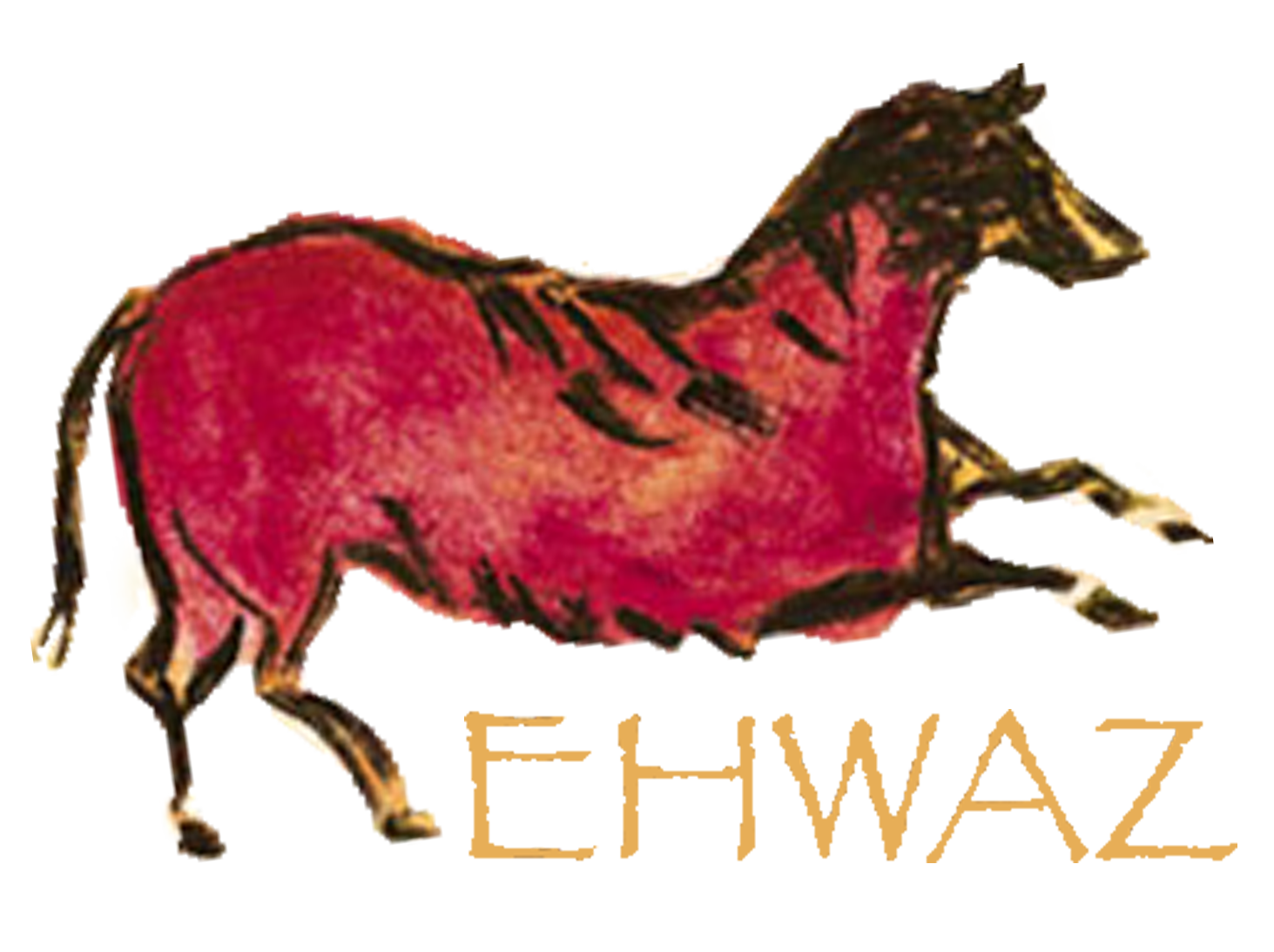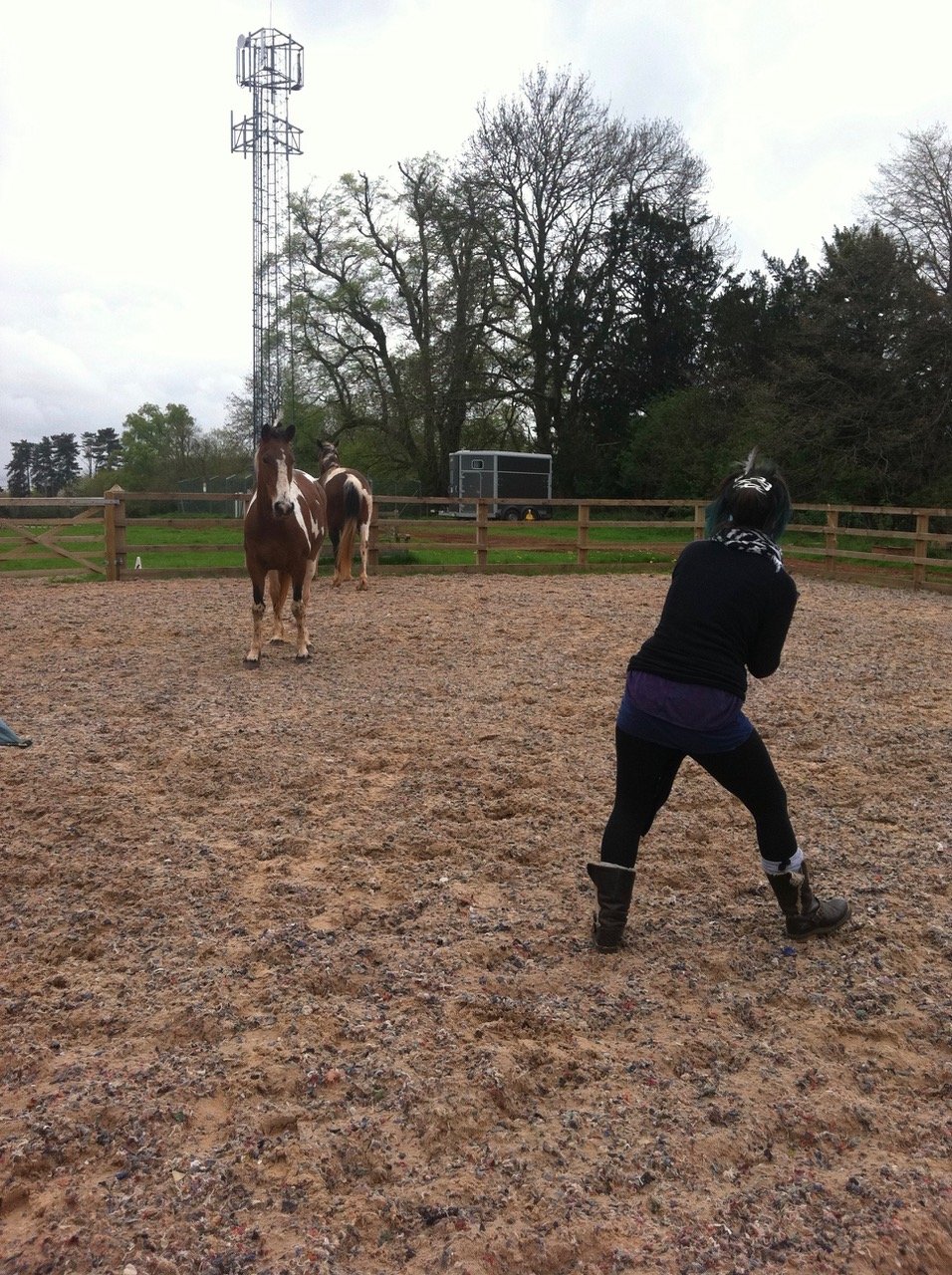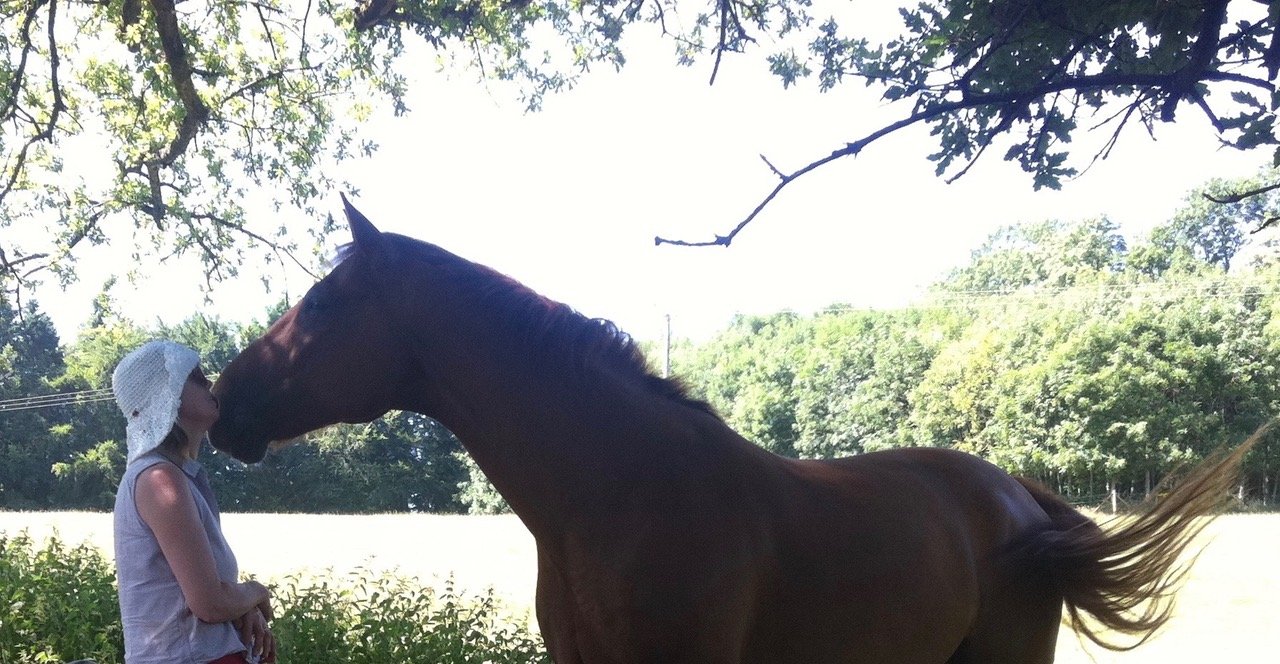When the Therapist is a Horse
Equine facilitated therapy is about entering the horse’s environment and using their presence to reflect back a sense of self. Nicola Banning describes her own, revelatory experience on a two-day workshop.
It’s a cold winter morning. A frost covers the ground and clear skies spread out across the Severn Estuary. I’m in the Forest of Dean to take part in an equine facilitated therapy (EFT) group run by equine facilitated psychotherapist Miranda Carey.
Day One
The group is already gathering in Miranda’s kitchen, making tea and signing the contracts for working safely with horses. The two-day group therapy takes place on the horses’ turf: out in the fields, with the herd. Miranda, who has over 15 years’ experience as a humanistic and integrative counsellor, first explains a bit about equine facilitated therapy (EFT – not to be confused with emotional freedom technique):
“‘The way I work with the horses is that they are free. The horses choose if and when they engage with the work. I work with the horse’s process and the client’s process. The horse is not used as a tool and nor is the client given exercises to do.’”
It’s a case of we humans entering the horses’ environment, a wild space, where they are without a head collar or a lead and they have the freedom to be with us – or not, as the case may be.
Opportunities to debrief and warm up are woven into the day and take place in a yurt, erected in a hollow in the landscape and heated by a wood- burning stove. It’s like a fairytale. I find a cushion and a blanket and we settle in a circle. I tune in and make a note of what I’m feeling. Apprehensive. Stirred. Vulnerable. I know I’m going to learn a lot this weekend.
You don’t need a background with horses to do this work, and it’s not about horse riding. In our group of eight or so women, some are experienced horsewomen, and others have no experience or admit to a fear of horses.
So what brings me here? Repeatedly I take to supervision the issue of power relations: in my client work, in training or facilitation work with groups and when working with organisations. I know horses make congruent teachers and I want to learn from them about holding my power, taking power, being directive or stepping back and how this might inform my work with clients, groups and organisations.
Miranda starts by explaining some safety issues integral to EFT. Horses are prey animals and are easily startled into fight or flight mode. We humans are their predators. These factors are both significant. Because they are prey, horses need to be really present for survival. An untrained human eye may struggle to read a horse’s emotional state, but the horse will have no problem picking up ours.
Miranda says that many people ask whether you can do this work with dogs. The answer is no. Unlike horses, dogs have a tendency towards obedience and express their emotions easily with a wagging tail, jumping up, growling or licking. Horses are harder to read. They are also much bigger, more powerful and not instinctively compliant. Because of this, they command our respect.
The horse’s prey status distinguishes them as particularly congruent therapists, it seems. In The Tao of Equus, Kohanov writes: ‘The common human habit of suppressing negative or socially unacceptable feelings is notoriously unsettling to a species that survives by being able to gauge a predator’s presence and intentions at a distance. [1]
Before meeting the herd, Miranda gives us a central message.
“‘You need to get into your bodies. Our bodies tell the truth. When we are real, the horses know. If you’re in your head, they’ll know.’”
More than that, the horses are constant mirrors and will reflect if a client is in or out of his/her body. I ask Miranda to explain further. ‘Well, Maud is a mare who picks up when people are not in their bodies. Maud will sometimes fall over with clients who have experienced abuse.
I will check out with the client: “Can you feel your feet?” And they’ll say things like: “I’ve never felt my feet” and “I can’t feel my legs”. But what helps them come into their bodies is that they are with an animal that they can touch and can be close to, and touch is very important in this work.’
To help us get into our bodies, Miranda gathers us outside and asks us to form a circle for a body scan. I close my eyes and notice what I’m feeling in my body.
Miranda asks a series of questions: ‘How grounded are you? Are you leaning more on one foot than the other?’ And: ‘Could a horse knock you over?’ What a revealing question. Yes is my answer: I’m not remotely grounded. I try out some rooting poses, squats, a nice deep bend at the knees, palms of the hands facing outwards. And then I feel strong.
I remind myself of the New Zealand rugby team doing the Hakka. I breathe deeply into my solar plexus.
The horses are in three fields. Miranda invites us to go and meet them – if, that is, the horses want to meet us. Watched by an observer, in case there is a need to intervene (whether for human or horse), we set off.
I’m not at ease as we head out. I’m feeling awkward and I’ve already gone into my head. After a while, the inner critic starts: ‘What if the horses don’t like you? Maybe you can’t do this...’ I feel vulnerable and a bit daft.
I take three deep breaths. I see some horses ahead and trudge towards them. I notice some of the group approaching the horses with apparent confidence.
I’m not feeling confident. One young woman, who earlier had appeared shy and defensive, is sitting down in the field in among three grazing horses; she seems completely at ease.
A horse approaches her, sniffs at her and stands over her. I watch as the horse nuzzles her hair and face while the young woman strokes it and talks to it in whispers. I can’t hear what’s said, but there is a gentleness now between them. It moves me to tears and I look away. Healing is happening here. I feel envy: I’d like some of that. A couple of horses walk towards me, sniff me, then walk off, uninterested, to graze.
I’m feeling rather dull, and they know it. The inner critic starts up again. Then I remember Miranda’s words: ‘Horses hate all that self-talk.’ I know that inner critic needs silencing. I tune into my body. I’m unsure, lonely and feeling a bit left out: that’s what’s going on inside.
I’m aware that this is familiar territory. I stay with the uncomfortable feelings. After some minutes, a pretty Palomino looks up and slowly approaches me.
Ah, the relief. I’ve been chosen. I’m unbelievably grateful. She stops andnuzzles me gently. For the briefest of moments I stand and breathe her in. Her big brown eyes are looking right into me. I sense acceptance. She blows through her nostrils, close to my heart.Then she turns, does a little buck and canters off. Blinking through tears, I head back to the warmth of the yurt.
I’m unsure quite what happened but I’m equally sure that something did. Looking back, it’s still hard to say what took place. There is a vague and illusive quality to the whole equine experience, which is unsurprising as it takes place in the feeling, intuitive, right side of the brain that is associated with the ‘feminine’.
Miranda had suggested we bring journals to note down our experience as close to the moment as possible, to help the left brain, the logical, rational side associated with the ‘masculine’, make sense of it.
Debriefing, Miranda explains that our communications with horses can be very short: ‘Horses don’t need a therapeutic hour,’ she says. Miranda tells me more about the Palomino horse I met. Nutlett has touched something deep in me. I learn that Nutlett struggles to find and display her active masculine power in the herd. Growing up in a male dominated family, I empathise.
This particular power dynamic is acutely familiar to me and I’m stunned by the horse’s insight. But I find her compassion healing. Strange, but true. Stories and connections unfold. The horses demonstrate a depth of knowing and wisdom that I find inspiring but not surprising. For example, two women form a bond with the same horse.
But the same horse is very different with each woman. With one she calmly nuzzles and accepts her attention quietly. With the other, she is more agitated, scratching and vigorously rubbing her rear on the gate. Then, turning back to the first woman, she resumes her calm. It transpires that the second woman has a skin condition and is feeling very itchy and uncomfortable around her back. The horse repeatedly reflects this discomfort in her behaviour.
This behaviour continues in our second day together: whenever the horse is near these two women, she’s calm with one and itchy and scratchy with the other.
We approach the end of day one. The experiences of the group reverberate around the yurt. I’m tired, but in a good way. It’s warm and I could sleep.
I’m struck by the powerful aspects of working therapeutically in nature. I’ve attended a good number of therapy, groupwork and professional development events, but I have never worked outdoors. Connecting and networking is valuable, but so too is being able to be fully here for myself.
I feel no need to make small talk or do anything other than listen to myself and be aware of the horses and our environment.
Day Two
I sleep soundly and wake with a sense of the horses. There’s a light drizzle as we gather to check in. Everyone seems more alive today. We leave the yurt to begin the body scan but today the horses have come to join us. Instead of being out of sight, they’re grazing close by.
Miranda had planned to ask us to stand with our eyes closed but appreciates we might feel safer if four large horses weren’t walking among us. She suggests instead that we do this work inside the round pen, so we can close the gate and keep the horses outside. The horses have other ideas. We walk into the round pen and they follow us, refusing to be shut out.
They find us interesting today – a reflection of where we are in our consciousness and in our bodies. The horses, it’s clear, like us this way. We gather and Miranda asks us to work in pairs: one half is asked to think of a negative script – for example, ‘I’m no good at this...’ – and then the other pushes her or him gently. Each time I’m pushed, I feel unrooted, as though I could be pushed over, literally.
Then she asks us to breathe deeply into our solar plexuses and to replace the negative script with a positive thought. This time, when my colleague pushes my chest, my feet stay firmly rooted: I’m not a pushover. It’s a quick exercise but it demonstrates powerfully the direct impact of our thought processes on our bodies.
Horses can read us and, quite simply, they know whether I (or we) can be pushed over or not. Holding this awareness, I make my way towards a big, dark horse standing at the top of a slope. He’s eyeing me as I approach, looking majestic up close, powerful. I walk towards him, barely registering the other horses grazing around. I stop below him and say ‘Hello’.
I’m aware of him above me and that I am standing under his head, small but not intimidated. I take time to connect. I breathe deeply and exhale. So does the horse. And then he opens his mouth wide, wiggling his jaws; his huge, long tongue comes out and he shows me his teeth. He stays with me, yawning, opening and closing his jaws and blowing through his nose. He nibbles my hand a little and I feel his teeth, but gently. He nuzzles my hair and his soft nostrils and whiskers tickle me.
Drawing close to my face, he blows warm breath around my mouth and nose. I bask in his warmth and we stand for a while. I lose track of time. I’ve no fear.
Tears pour down my face as we stand together in this silent communication. Big Horse seems to like my tears. ‘When we cry, horses release.’ That’s what Miranda has told us, and that’s what he’s showing me, by yawning, stretching his tongue and licking. The smell of the horse surrounds me, my nostrils, hands and face. It’s wonderful.
Time passes and I sense that it’s time to leave. It’s a little like saying ‘Goodbye’ to an irresistible lover, but without any sadness or longing. I make my way back to the group. Miranda notices me and asks if I’m OK. I assure her I am. I don’t need to say anymore. She offers a quality of holding that makes this potentially volatile work with horses feel very safe.
Later there’s an opportunity to do an active piece of work with a horse in the round pen. Buoyed by my experience with Big Horse, I seize the chance.
Supportively observed by the group, I step into the round pen with a horse called Maud. The idea is to engage with my masculine energy, which is what you need to do to direct a horse. It looks effortless, but it isn’t. To make a horse move is to engage with your own power, to be directive, to get the horse to do something that you want it to do.
I befriend Maud first. And then I start to make her move, gently encouraging her to walk with me. There’s no head collar or lead, but she’s now walking with me because she wants to. As I feel more confident, I start to feel lightness in my step. I become playful, getting her to trot with me. Maud’s actions reflect mine: if I want her to increase her energy, I have to show her mine.
Reflecting now, I can see a parallel with facilitating groups, being directive, and taking people with me but, in the round pen with Maud, I lose track of time and all sense of being watched.
We come to a stop and I stroke Maud and thank her. I come out of the round pen, blinking and happy. Miranda asks me if I want feedback from the group.
Having lost all sense of being observed, I’m curious to know what others saw. One woman is crying as she describes the quality of communication between Maud and me. Something about the way I directed Maud without being controlling moves her greatly. Later, while writing this article, I call Miranda to ask her what she saw; I’m struggling to express it. ‘That’s interesting,’ she says, ‘because what I saw between you appeared so easy and effortless. I saw a lovely connection between you and Maud. You were in sync with one another. You just went in and you moved together. Maud won’t do anything unless she’s being respected.
You were very much collaborating. You didn’t have to pick up a stick and use it. And you didn’t have to be dominant.’ We return to the yurt to draw the weekend’s work to a close.
Miranda asks us how we’ll take away our experience with the horses. I hold an image of me standing under Big Horse on a slope, with him towering above me. I’m small underneath him and he’s majestic and powerful. But I hold my space, facing him. I leave with the memory, in my body, of what it felt like to be really present with the horses, to hold my ground, to be directive and to feel nourished by their spirited presence. [2]
After so many years of working therapeutically as a counsellor, and of my own therapy, professional development and yoga practice, I thought I knew about being present. But, through EFT, the horses are teaching me how much more I have still to learn. If we listen, horses can teach us so much about how we relate to the world and how we’re experienced by others.
Perhaps, as Linda Kohanov so eloquently puts it: ‘At a time when horses are no longer required to work in our fields and carry us to war, they can do something arguably more important – work on us.’ [3]
Nicola Banning is a funeral celebrant, a writer and a former therapist with over 20 years' experience.
References
1. Kohanov L. The tao of equus. California: New World Library; 2001, p32.
2. Kohanov L. Riding between the worlds. California: New World Library; 2003, p129.
3. Kohanov L. The tao of equus. California: New World Library; 2001, pxxii.
Article originally published in Therapy Today in March 2012.



